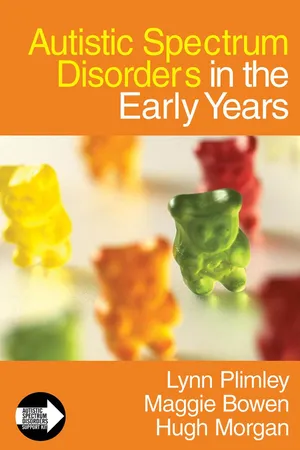
- 112 pages
- English
- ePUB (mobile friendly)
- Available on iOS & Android
Autistic Spectrum Disorders in the Early Years
About this book
Looking at the early years of a child?s life, this book provides information on the services that are available for those from birth to five years, and addresses issues related to identification, assessment, teaching and learning and family support.
It is illustrated with case studies provided by parents and practitioners.
The following areas are discussed:
o the Code of Practice for SEN & the SEN and Disability Discrimination Act
o identification and assessment
o good practice examples of multi-agency collaboration and provision
o partnership with parents
o social skills and behaviour
o alternative intervention and home-based programmes
o the transition from pre-school to school.
Professionals in Health, Social Services and Education, pre-school playgroups, nursery staff, parents and carers will all find this book useful.
Conference Information
The Good Autism Practice (GAP) conference is based on the successful foundations of the Good Autism Practice (GAP) journal, which provides a platform for acknowledging and sharing good practice in autism.
Frequently asked questions
- Essential is ideal for learners and professionals who enjoy exploring a wide range of subjects. Access the Essential Library with 800,000+ trusted titles and best-sellers across business, personal growth, and the humanities. Includes unlimited reading time and Standard Read Aloud voice.
- Complete: Perfect for advanced learners and researchers needing full, unrestricted access. Unlock 1.4M+ books across hundreds of subjects, including academic and specialized titles. The Complete Plan also includes advanced features like Premium Read Aloud and Research Assistant.
Please note we cannot support devices running on iOS 13 and Android 7 or earlier. Learn more about using the app.
Information
1
A guide to gaining a basic understanding of people on the autistic spectrum
Classical autism
Childhood schizophrenia
Asperger syndrome
Autistic features
Childhood psychosis
Lack of theory of mind
Pathological demand avoidance
Idiot savant
Pervasive developmental disorder
Pervasive developmental disorder – NOS (not otherwise specified) Central coherence difficulties
Semantic pragmatic disorder
Executive function deficit
- social interaction
- communication
- rigidity of behaviour and thought.
Social interaction
- Preference for individual activities
- Apparent aloofness
- Indifference towards others
- More adult-oriented than peer-oriented
- Likely to exhibit different spontaneous responses
- Passive acceptance of contact
- Lack of empathy
- Failure to appreciate significant others
- Poor understanding of social rules and conventions
- Inability to seek comfort at times of distress.
Aloof
Passive
Active but odd
Communication
- Little desire to communicate socially
- Lack of understanding of non-verbal gestures of others
- Not appreciative of need to communicate information
- Idiosyncratic use of words and phrases
- Prescribed content of speech
- May talk at rather than to
- Poor grasp of abstract concepts and feelings
- Literal understanding of words and phrases
- Does not ‘get’ subtle jokes
- Will develop expression before understanding.
Rigidity of behaviour and thought
- May have stereotyped activities
- Can become attached to repetition of movement or certain objects or routines
- Complex order of activity
- Cannot deviate from one way of doing things
- May be tolerant of situations and then overreact to something minor
- May develop rituals that have to be completed
- Can have extreme physical rituals – e.g. spinning, rocking
- Can develop extreme behaviours to avoid certain stimuli.
REFLECTIVE OASIS

Difficulty in social situations that require a spontaneous response
Repetitive quality to interactions and routines
Will copy but not necessarily understand
Inability to see cause-and-effect of their own behaviour
Holds black-and-white views
Doesn’t understand subtlety/sarcasm/jokes/irony
Cannot create spontaneously without a model or intensive input
May not transfer skills and concepts learned in one situation to other settings/people/topics
Table of contents
- Cover Page
- Title
- Copyright
- Contents
- Acknowledgements
- How to use this book
- 1 A guide to gaining a basic understanding of people on the autism spectrum
- 2 Identification and assessment
- 3 Family relationships
- 4 Partnership with parents
- 5 Multi-agency collaboration and service provision in the early years
- 6 Using a statutory framework to enhance service provision in the early years
- 7 Social skills training – self-help skills
- 8 Managing behaviour
- 9 Community involvement – helping young children to cope in the outside world
- 10 Alternative intervention and home-based programmes
- 11 Transition planning
- References
- Useful Websites
- Sources of information
- Glossary
- Index